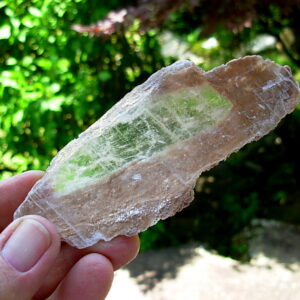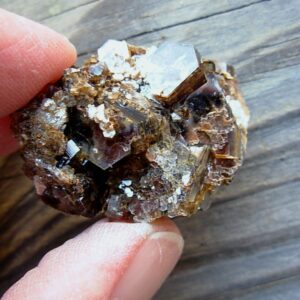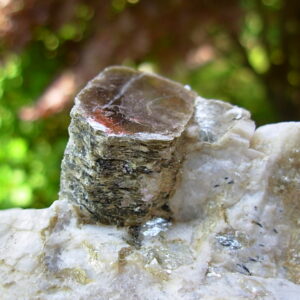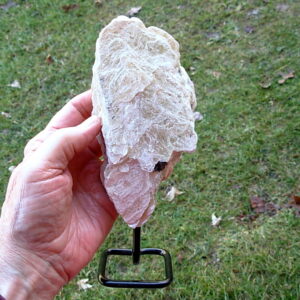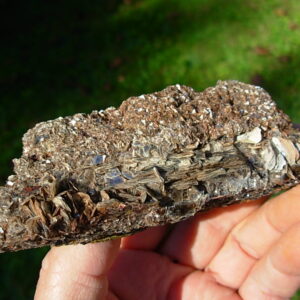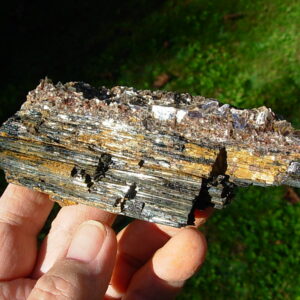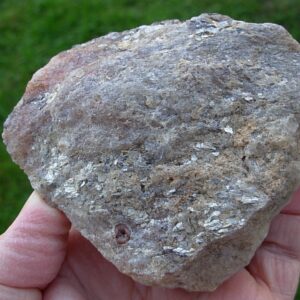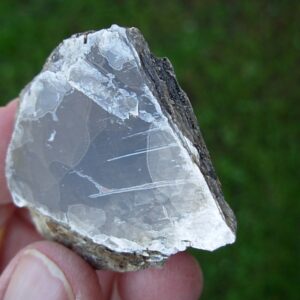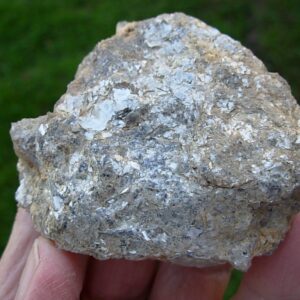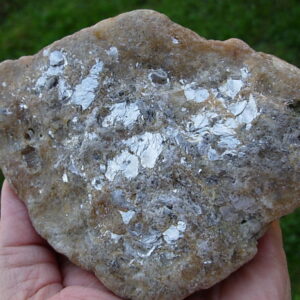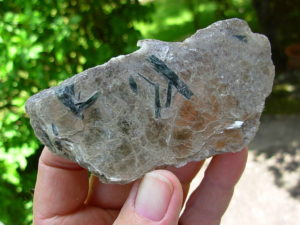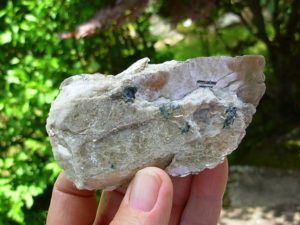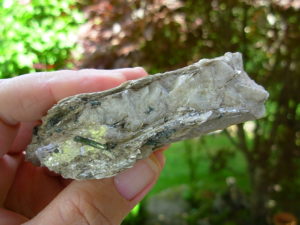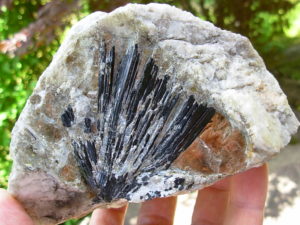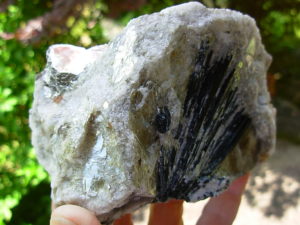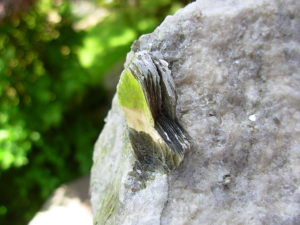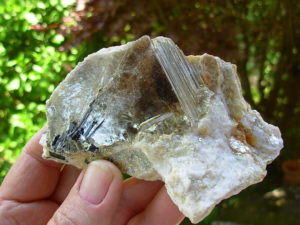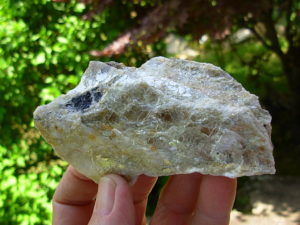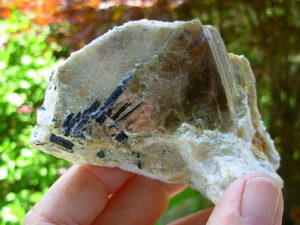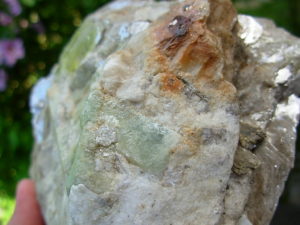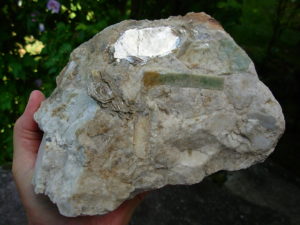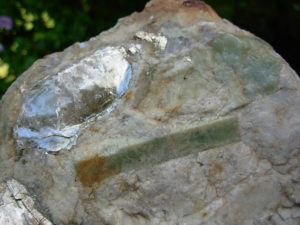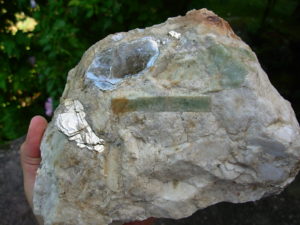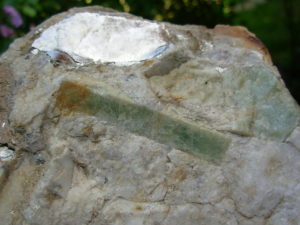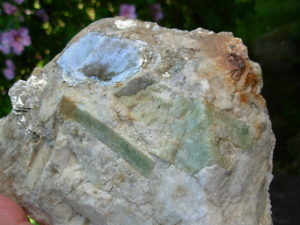Muscovite, Mica, Isinglass
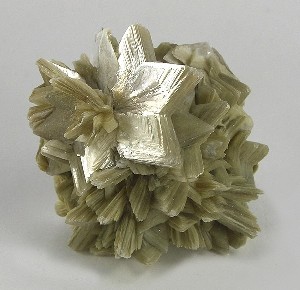 Muscovite is a silicate mineral that contains potassium and aluminum. It is also known as Mica or Isinglass. Muscovite may form in layers of sheets (called “Books”) which are clear with a pearly luster on cleavage faces or as a rock forming mineral found in igneous, metamorphic and sedimentary rocks, often having a flakey, sparkly look.
Muscovite is a silicate mineral that contains potassium and aluminum. It is also known as Mica or Isinglass. Muscovite may form in layers of sheets (called “Books”) which are clear with a pearly luster on cleavage faces or as a rock forming mineral found in igneous, metamorphic and sedimentary rocks, often having a flakey, sparkly look.
Muscovite typically occurs in metamorphic rocks, particularly gneiss and schist, where it forms crystals and plates. It also occurs in igneous rocks such as granites and fine-grained sedimentary rocks. Large crystals of muscovite are often found in veins and in pegmatite.
The name “Muscovite” comes from the term “Muscovy-glass”, a name formerly given to the mineral because it was actually used in Russia for windows.
Muscovite reflects light strongly from broken fragments. This is caused by a natural cleavage resulting in thin sheets (“Basal Cleavage”). Sheets naturally form in alternating layers, resulting in Muscovites distinctive shape. When the sheet growth is unobstructed they form hexagonal sheets. A unique variety in Brazil forms yellow five pointed stars and is called "Star Muscovite".
Muscovite is usually clear but may be silvery, coppery silver, light gray, brown, pale green, or rose-red in color depending on the thickness of the sample and presence of impurities.
The Mica Group
Large crystals of mica used for various applications are typically mined from granitic pegmatites. Collectible Mica specimens in the USA can be found in Spruce Pine, Franklin-Sylva and Shelby Hickory districts of North Carolina.
The mica group of sheet silicate (phyllosilicate) minerals includes several closely related materials having nearly perfect basal cleavage. Mica is normally found to be monoclinic (pseudo hexagonal), there also are hexagonal, orthorhombic, and triclinic forms generally referred to as polytopes. Among the principal rock-forming minerals, micas are found in all three major rock varieties; igneous, sedimentary, and metamorphic.
Of the 28 known species of the mica group, only 6 are common rock-forming minerals.
1) Muscovite, (Potassium Mica) the common light-colored mica. It was originally called “Muscovy glass” because it came from the Muscovy province of Russia
2) Biotite, (Magnesium Iron Mica) which is typically black or nearly so, is the most abundant. Biotite was named for Jean-Baptiste Biot, a 19th-century French physicist who studied the optical properties of micas.
3) Phlogopite, (Magnesium Mica) typically brown. Its name comes from the Greek word ‘phlogopos’ for fire like, which was chosen because of the reddish glow (color and luster) of some specimens
4) Paragonite, (Sodium Mica) which is macroscopically indistinguishable from muscovite, also is fairly common. From the Greek word ‘paragon’ “to mislead,” was so named because it was originally mistaken as talc.
5) Lepidolite, (Lithium Mica) generally pinkish to lilac in color, occurs in lithium-bearing pegmatites. From the Greek word 'lepidos' meaning “scale,” was based on the appearance of the mineral’s cleavage plates
6) Glauconite, (Iron Potassium Phyllosilicate Mica) a green species that does not have the same general macroscopic characteristics as the other micas, occurs sporadically in many marine sedimentary sequences. All of these micas except Glauconite exhibit easily observable perfect cleavage into flexible sheets. Glauconite, which most often occurs as pellet like grains, has no apparent cleavage. Although typically green, was named for the Greek word for blue ‘glaucos ‘
Muscovite is the most common type of Mica. Whenever the word mica is used, it is normally understood to mean muscovite. Mica is also known as Cat-gold, Cat-silver, Glimmer, Glist, Katen-silber, Katzen-silber, Katzengold, Or Des Chats, and Rhomboidal Mica.
Mica is found to occur in book form in pegmatites intruding mica schists. The presence or absence of orthoclase feldspar indicates the chances of finding mica in the pegmatite. Mica forms at the expense of orthoclase feldspar. The presence of tourmaline crystals and decomposed feldspar in the pegmatites is a great indication of the possible formation of high quantity of mica.
Mica pegmatites have been found to occur in various shapes and sizes mostly occurring as lenses. They may occur as veins or in massive form. It is difficult to know when the vein will play out making the mining of mica highly speculative and risky. The sudden change of surrounding minerals resulting in total disappearance of mica from the working area is common.
A rare crystallized Mica that can be found near Shelby, Cleveland County, North Carolina is a 6 sided Phlogopite Mica. It has sharp, well defined mica crystals and most specimens have a red-brown clay in the crevices between the crystals. The mica crystals are brown, platy hexagonal form, with secondary edge faces. When back lit or viewed in the correct sunlight angle the crystals show translucent solidification of the mica plates. These are highly sought after North Carolina crystallized Mica specimens!
-
Clear Mica from Ellensburg Depot NY
$26.00 Read more -
Crystallized Mica from Shelby, Cleveland County, N.C.
$24.00 Read more -
Crystallized Mica from Shelby, Cleveland County, N.C.
$25.00 Read more -
Large Book of Phlogopite Mica on Pegmatite from N.C.
$69.00 Add to cart -
Muscovite (Potassium Mica) specimen on steel stand from Brazil
$39.00 Add to cart -
Muscovite on Black Tourmaline from Brazil
$39.00 Add to cart -
Muscovite on Black Tourmaline from Brazil
$34.00 Add to cart -
North Carolina Mica Specimen
$18.00 Add to cart -
North Carolina Mica Specimen
$17.00 Add to cart -
North Carolina Mica Specimen
$15.00 Add to cart -
North Carolina Mica Specimen
$22.00 Add to cart -
North Carolina Mica Specimen
$22.00 Add to cart
Item # 9MIC06168232
Tourmaline in Phlogopite Mica from North Carolina

This brown Magnesium Mica specimen (phlogopite) has multiple layered crystals with attached green Tourmalines and white quartz. This specimen is from the Spruce Pine District in Mitchell County North Carolina Appalachian Mountains. This is a very special collection piece.
Specimen weighs 6.3oz or 0.39 lb (181g) and measures 3.9 x 2 x 0.97" (10 x 5.2 x 2.47 cm)
Item # 10MIC06164433
BlackTourmaline on Phlogopite Mica from North Carolina

This Magnesium Mica specimen (phlogopite) has a mica book (25 x 19 x 8mm) and a second large mica window covered with black Tourmalines (Schorl) in pegmatite matrix. This specimen is from the Spruce Pine District in Mitchell County North Carolina Appalachian Mountains. This is a very special large cabinet collection piece.
Specimen weighs 36.5oz or 2.28 lb (1037g) and measures 5 x 3.9 x 3.1" (12.8 x 9.9 x 7.9 cm)
Item # 14MIC06164402
BlackTourmaline on Phlogopite Mica from North Carolina

This Magnesium Mica specimen (phlogopite) has a mica book covered with black Tourmalines (Schorl) in pegmatite matrix. This specimen is from the Spruce Pine District in Mitchell County North Carolina Appalachian Mountains. This is a very unique cabinet collection piece.
Specimen weighs 5.8oz or 0.36 lb (165g) and measures 4.1 x 2.3 x 0.86" (10.5 x 5.8 x 2.19 cm)
Item # 32MICB07165943
Muscovite and Beryl Crystals from Yancey County, NC

This is an extra-large cabinet specimen of Feldspar and Quartz matrix with brown Mica (Muscovite) and large green beryl crystals. This piece is from an old collection we acquired and was in a box marked from the Ray Mine in Burnsville, Yancey County, North Carolina. This is a beautiful specimen from a great location.
This specimen weighs 106 oz or 6.63 lbs (3010g) and measures 7.9 x 5.3 x 3.3 inches (20.1 x 13.5 x 8.5 cm) One Beryl Crystal is 2.4 x 0.56" (63 x 14.4mm) the second is @ 1" x 1" (27 x 27mm)

